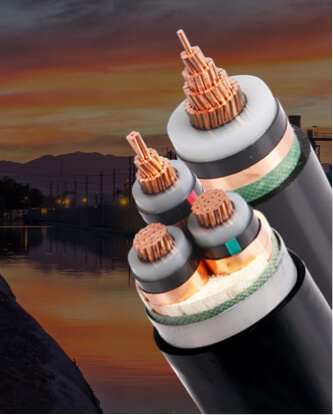
Comprehensive interpretation of power cable classification
2024-11-11
Comprehensive interpretation of power cable classification
Power cables can be divided into many types according to different standards. Here are some common categories and their specific types:
Classification by use
Distribution cable: Used to distribute electricity in urban or industrial areas.
Transmission cable: Used to transfer large amounts of power over long distances, usually at a high voltage.
Control cable: Used to transmit control signals, commonly found in automated control systems.
Classification by insulation material
Polyvinyl chloride (PVC) insulated cable: low cost, good heat resistance, widely used in low-voltage distribution systems.
Crosslinked polyethylene (XLPE) insulated cable: has good electrical and mechanical properties, suitable for medium and high voltage transmission lines.
Rubber insulated cable: has good softness and aging resistance, suitable for mobile devices.
Mineral insulated cable (MI cable) : excellent fire resistance, suitable for places with high safety requirements.
Classification by conductor material
Copper cable: good conductivity, relatively high cost, widely used.
Aluminum core cable: lower cost, light weight, but not as conductive as copper under the same cross-section.
Classification by structure
Single-core cable: Usually used for high-voltage transmission, it can reduce the influence of skin effect and proximity effect.
Multi-core cable: including two core, three core, etc., mainly used in low-voltage power distribution and control circuits.
Shielded cable: A shielding layer is added to the outer layer of the cable to reduce electromagnetic interference.
Classified by laying method
Overhead cable: installed on poles, suitable for open areas.
Underground cable: buried in the underground cable, suitable for urban areas, with better security and concealment.
Underwater cable: Specially designed for crossing the sea or river cable, need to have good waterproof performance.
Classification by voltage level
Low-voltage cable: generally refers to 1kV and below the cable.
Medium voltage cable: usually refers to the cable above 1kV to 35kV.
High voltage cable: refers to the cable above 35kV, including ultra-high voltage and UHV cable.
These classifications are not isolated, and power cables in practical applications may meet multiple classification standards at the same time. Choosing the right cable type takes into account the specific application environment, safety requirements, and economic factors.
The temperature resistance of the cable refers to the ability of the cable to work normally within a specific temperature range without performance degradation or damage. Different types of cables, due to their different materials and structures, the temperature resistance will also be different. The following is an overview of the temperature resistance of several common cables:
Polyvinyl chloride (PVC) insulated cable
Temperature range: -40°C to 70°C (common type), can be modified to 90°C or 105°C.
Features: low cost, good heat resistance, moderate flexibility, easy processing and installation.
Application scenario: residential, commercial buildings, industrial facilities and other low-voltage power distribution lines.
Cross-linked polyethylene (XLPE) insulated cable
Temperature range: -40°C to 90°C (normal type), up to 125°C or more by irradiation crosslinking.
Features: Excellent electrical and mechanical properties, good heat resistance, allowing higher current carrying capacity.
Application scenarios: medium and high voltage transmission lines, urban power grids, industrial power supply systems.
Rubber insulated cable
Temperature range: -40°C to 90°C (common type), 135°C can be modified.
Features: Good softness, strong aging resistance, low temperature resistance, suitable for frequent moving occasions.
Application scenarios: Mobile devices, construction sites, mines and other occasions that require frequent movement.
Mineral Insulated Cable (MI Cable)
Temperature range: -25°C to 250°C, some special models can reach 750°C or higher.
Features: Excellent fire resistance, even at high temperatures can maintain the integrity of the circuit, high safety.
Application scenario: high-rise buildings, subways, nuclear power plants and other places with high safety requirements.
Silicone rubber insulated cable
Temperature range: -60°C to 200°C.
Features: Good high and low temperature resistance, acid and alkali resistance, oil resistance, no combustion, suitable for high temperature and harsh environment.
Application scenario: high temperature mobile cable, soft power cable, motor lead cable, low temperature environment High temperature operation site.
High temperature 800°C fire-resistant cable
Temperature range: up to 800°C.
Features: The internal structure includes pure nickel wire, mica winding layer, glass fiber braided insulation layer and outer sheath, all made of refractory materials.
Application scenario: electric heating, petrochemical and other high temperature operation fields.
Special cable
Temperature range: Depending on the material and design, the temperature range can be from -60°C to 250°C and beyond.
Features: With special temperature resistance, corrosion resistance, radiation resistance and other properties, suitable for specific industrial and military fields.
Application scenarios: aerospace, nuclear industry, ocean engineering, etc.
Standards and certification
Different countries and regions have different standards and certification requirements for the temperature resistance of cables. For example:
UL standard: Common temperature classes are 60°C, 70°C, 80°C, 90°C, 105°C, 125°C and 150°C.
EN/IEC standards: mainly focus on the long-term operating temperature or temperature index of conductors, and the evaluation method is determined by aging tests of materials at different temperatures.
National standards: China's national and industry standards refer to UL and EN/IEC standards in the preparation process, but have some of their own regulations and requirements.
By understanding these temperature resistance properties and standards, you can better select and use cables that are suitable for specific application scenarios.
Quick Quote
* Note: Please be sure to fill in the information accurately and keep the communication open. We will get in touch with you as soon as possible

Copyright © 2023 Shandong Zhongmai Cable Co., Ltd


